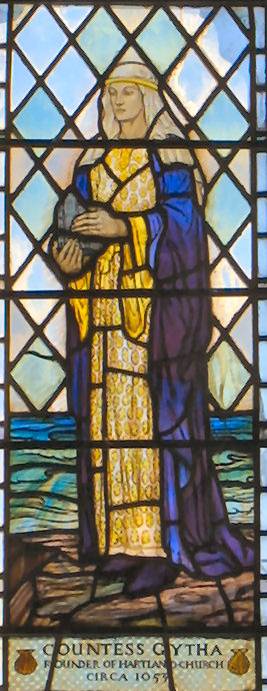
Part of Caroline Townshend and Joan Howson window at St Nectan’s Church. Countess Gytha
I have done a lot of research into my family history: one branch is the surname Giddings. I was therefore interested to see that there is a village with that name in Huntingdonshire. I have traced the Giddings family back to a small village called Urchfont in Wiltshire where the church records list the birth of John Giddings in 1530 as Geydding.
This is very close to the old English spelling Gydddingas which translates to followers / family of Gydda and is pronounced Gitt-ingas. Gydda, and her actions, are mentioned in a contemporary source The Anglo-Saxon Chronicles. Gydda Thorkelsdottir was a Princess of Denmark. Where she was born about 997 to Thorgil Sprackling. She came to Wessex to marry Earl Godwin who was Earl of Wessex. At that time Wessex made up Wiltshire and Somerset. She and Godwin had 5 sons and 3 daughters. Tosting was killed at the Battle of Stamford Bridge, in Yorkshire, when he supported the Norwegian King Harald Hardrada in September 1066 against her second son Harold who was Earl of East Anglia from 1044 to defend the shores from King Magnus of Norway.
In defending the battle of Stamford Bridge in September 1066 meant the Saxon men had no time to get between Yorkshire and Hastings to defend their shores from the Normans and they arrived at the battle already exhausted. There were no survivors and the bodies were unrecognisable. After the battle Gydda spoke to William the Conqueror about gathering her family for a more honourable burial but he was not helpful. Furious Gydda led a rebellion in Exeter in 1067. William lay siege to the city. Gydda negotiated terms which included taking the remaining Saxon court back to her family in Denmark the King of Denmark Sweyn Estridsson.
Her surviving (and youngest) son, Wulfnoth, lived nearly all his life in captivity in Normandy until The Conqueror’s death in 1087. Only her eldest daughter, Queen Edith (d. 1075), originally named Gydda, for her mother, still held some power (however nominal) as the queen consort of Edward the Confessor. Gydda’s children were powerful Earls or married into Royal courts. Sweyn Godwinson, Earl of Herefordshire, Gyrth Godwinson, Leofwine Godwinson, Earl of Kent and Ælfgifu of Wessex. All except Gunhilda of Wessex who was dedicated to God as a nun which is what royal families did in Anglo-Saxon times following their conversion to Christianity.
I think that Gidding village is possibly named after Gydda Thorkelsdottir which means its current name dates a little later than the 600s but after an extremely brave Anglo-Saxon lady.

